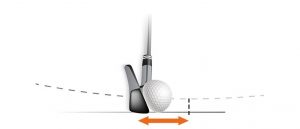Don’t be Swayed into Shorter Drives
One of the most debilitating moves in the golf swing that can rob any golfer of power and speed is the Sway. This happens visually when the hips move laterally away from the target in the backswing. This move almost always leads to many other swing faults.
There are some great ways to help fix the Sway, some can accidentally have the wrong effect by shifting your awareness to the wrong side of your trail foot. An angle iron from your local hardware store can be used to give you a great functional drill that can also be used while hitting balls.
Drive for Dough & Putt for Show!
You’ve all probably heard this saying before and are thinking that I’ve gotten it backwards… but since the ShotLink era on the PGA Tour we are now able to prove with 100% accuracy that the number one statistics correlation to where you finish on the money list is not Putting!!
Now I’m sure that many of you remember the amazing putts that Tiger used to make coming down the stretch to win tournaments and you’re questioning this Drive for Dough concept. The thing about these wins is that when you look at how Tiger performed against the Field, the wins were rarely due to his putting, but usually his Tee to Green play.
The #1 statistic that correlates to how much money you make on the PGA Tour is…. Strokes Gained Tee to Green! In other words, it’s how well you hit the ball from the Tee to the Green relative to the rest of the players.
What is Strokes Gained? The basic concept is that if the PGA Tour averages 1.8 strokes on a 10 foot putt and you make the putt… You’ve gained 0.8 strokes on the field. Miss that putt and you’ve lost 0.2 strokes to the field. Click HERE for the detailed answer.
Let’s look at the current Money List compared to Strokes Gained Tee to Green Vs. Strokes Gained Putting….
| Money | Player | SG Tee to Green | SG Putting |
|
1 |
Justin Thomas | 10 | 27 |
| 2 | Jordan Spieth | 2 | 29 |
| 3 | Dustin Johnson | 1 | 60 |
| 4 | Hideki Matsuyama | 4 | 148 |
| 5 | Jon Rahm | 6 | 22 |
| 6 | Rickie Fowler | 13 | 2 |
| 7 | Brooks Koepka | 61 | 21 |
| 8 | Kevin Kisner | 32 | 13 |
| 9 | Brian Harman | 92 | 6 |
| 10 | Marc Leishman | 16 | 45 |
| Total | 237 | 373 | |
| Based on 2017 Stats as of 9.7.17 | |||
So let’s learn to hit the ball further so that you can hit shorter clubs into the greens, then we’ll work on hitting the approach shots closer so that you can improve your Strokes Gained Tee to Green!
Here’s a couple Stats programs where you can keep track of your own Strokes Gained!
In the meantime, here’s a few tips on how to hit the ball further!
Gotta Keep your Head Up for the Wedge Yips
We’ve all seen someone or had the yips ourselves, especially when trying to hit a high soft pitch off a tight lie… Here’s where I see the masses using the classic tips from their friends to send them spiraling into the full on yips! Please please do Not ‘keep your head down!” Please do not ‘hit down’ on the ball… put the ‘ball back in your stance’… no thank you, ‘lean the shaft forward’…only if you don’t like money!
These are all fixes that we all have heard a million times and, although as band-aids, you may get some short term relief with these feelings, you will end up causing more harm than good. Granted, some of these may work much better with the full swing, however, the full swing and soft finesse wedges should be played in the opposite manner in almost every single way!
In most every case I’ve seen, those with the wedge yips have given themselves the yips by applying full swing components to their finesse wedges and then compounding the situation by applying full swing fixes to their new problems! It’s a vicious cycle.
Even when viewing 3D data of Tour finesse wedge shots versus full swings, you will see a sequence that is almost completely opposite of the Tour full swing.
Debunking Bunkers
One could have their club enter the sand 2″ behind the ball an hit great sand shots and hit terrible sand shots. Even still, people continue to obsess about where the club should enter the sand. I believe this focus is one of the main causes for people’s fear of hitting poor bunker shots.
The first piece to understand is the term Low Point, which refers to the absolute bottom of the swing arc. Combine this with Divot Depth and we are on to the real source of hitting great bunker shots.
In the scenario above where the club enters 2″ behind the ball, you will hit a long thin shot if your divot depth is only .25″ below the ball. A chuncked shot will result from going 2″ below the ball and a good shot will come from being rounghly 1″ below the ball. These numbers can change greatly based on the firmness of the sand because a soft beachy surface will allow the club to dig much easier. Conversely, with very firm sand it will be difficult to go too deep.
If your Low Point is too far behind the ball, it will become very difficult to have the club travel the correct depth and speed by the time it gets to the ball. This can lead to short flubs if the club is moving slowly and if the club exits the sand into the ball, the dreaded skull. If your Low Point is too far ahead of the ball, your tendency will be to skull the shot as the club is still traveling downward or chunk the shot from coming in too steeply.
This is why I prefer my players to keep their focus on getting their Low Point under the ball with the desired depth for the shot and surface they’re playing from.
Designing a Swing Around Your Body
If you want to swing like Adam Scott, then you’ll have to have the same body as Adam Scott! Here’s a look a how we create a golf swing for our students by focusing on what their body can and cannot do. We must know what your body’s range of motion is before any changes can be made so that we don’t try to make you move in a manner you’re not capable of.
This process always begins with our Full Game Assessment where we find you range of motion via the TPI Body Screen. This is followed by data collection with a Flightscope X2 which tells us what the golf ball is doing and therefore what the club head is doing at impact. The KVest 3D motion capture system tells us what the body is doing and helps us understand how that is effecting the club’s motion. Finishing with a Foot Pressure Map from Boditrak Sports to create a picture of how the golfer is using the ground to move. This data is correlated into a measurable set of goals for us to achieve during a stated time period.
Please watch this 4 part video series to see how this plays out with one of our students.
The Poor Man’s Trackman
Low Point is an extremely important term when looking to improve your ball striking. Trackman defines it as “the lowest point on the swing arc”. The easiest way to understand Low Point is that if your lowest point is before the ball, you will tend to hit the ground first. Trackman and Flightscope will give us this point based on being before or after impact. The image below will give you a good idea of what it looks like to have your low point after impact.
Although Trackman, etc, are extremely precise, we can use our smart phones high speed cameras to ball park it close enough to improve our ball contact and hit the ball further.
The Slicer’s Fix
Throwing a football, baseball, tennis serving, side arm pitching and my favorite… skipping a stone across a lake! What do these have in common? The trail shoulder/arm always rotates away from the target during transition. Slicers will rotate toward the target in transition.
Please also watch the Slicer’s Wrist Angle video for the complete understanding.
For Players & Coaches – Accountability, Randomization & Challenge Point
Golf is not played by hitting a pyramid of 7 irons and drivers. The only time you’ll ever hit the same club twice is when the first one goes out of play. We need to make our practice more like real golf by hitting different clubs and different shots. This is making your practice more random.
During real round of golf you will be held accountable for every shot you hit. You have to chase them down and count them all! However, most of our practice contains zero accountability since there’s an entire bucket of balls waiting for you and it really doesn’t matter where you hit it. By increasing your accountability during practice you will not only keep yourself more engaged but you will also find out what your new move will do when the pressure is up!
Challenge Point refers to maintaining a level of difficulty that is just barely reachable, therefore engaging and fun. If you were asked to make 20 one foot putts, you would quickly become bored with such an easy task. On the other hand, 20 twenty foot putts in a row would be extremely difficult and would more often hurt confidence than build it. The challenge at hand needs to be attainable with decent effort, thereby keeping you engaged in the process and feeling accomplished.
3up, 3down asks you to begin with a higher lofted club like at 9 iron. If you hit 3 good shots before you hit 3 bad shots, you move up to the 8 iron. If 3 bad shots come first, you move down to the pitching wedge. The goal is to get through the driver. This should be used as a new skill/motion is being found. Once the new skill becomes more ingrained, you will need a more challenging performance game.
3up, 3down encompasses Randomization because it get you hitting every club in your bag and switching clubs frequently. Accountability is achieved by having to deem each shot ‘good’ or ‘bad’ and by being forced to switch clubs based on your performance. Challenge Point is used because every person has a different definition of ‘good’ and ‘bad’. The greatest level of Challenge Point will be found as the player gets into the longer clubs and begins to ‘loose’ the feeling. They will be forced to go back down and find the feeling again before they can go back up. That point where they lose the feeling is when the challenge at hand becomes greater than their use of the new skill. The more you operate in this zone, the higher the engagement and retention become.
Control Your Scoring Wedges
The full swing with scoring wedges will cause your trajectory and spin rate to increase, however, the consistency of both will also decrease. If we’re trying to control the shot with our scoring wedges, we will need to use a motion that is also more controlled. We need to use a more balanced swing, rhythmically speaking, where the speeds on both side of the ball are very similar. This is where the 10 to 2 idea comes into play.
Think of the face on view of your swing which puts your head at 12:00 and your feet at 6:00. The 10 to 2 swing references the point your hands/arms reach the 10:00 and 2:00 positions. For a left hander, this shot would be 2 to 10.
This shot will require less hand/wrist action which will help control spin rate and trajectory. The slower swing speed will also help to decrease both trajectory and spin rate.
When you go to practice this shot your first priority is not how far it goes. First priority is the rhythm necessary to keep the swing at 10 to 2. You will find it much easier to hit the 10:00 than the 2:00, which will indicate that the 2:00 is the more important focus. Once you’ve figured out the 10 to 2 rhythm, start checking your distances with each wedge in your bag.
Straighten Out Your Short Sided Flops
We’ve all seen Phil Mickleson hit his crazy flops that look like a full swing, lots of dynamic action and hand speed. Let’s face it, we’re not Phil. Often the biggest mistake is from overusing the hands and arms to hit down on the ball. This can make contact very scary as our fear of skulling the shot will cause us to dig down at the ball.
To counteract this tendency and shallow out the club’s angle of attack, please keep your right arm straight. We want your hands and the club to stay as far away as possible, which will also keep the handle in front of your chest. This goes for the backswing as well as the downswing.
This will also encourage a large shoulder turn to generate the power source that we removed by taking out the lever at your right elbow as well as quieting the wrist action. This will help give your motion an longer yet more rhythmic action.










